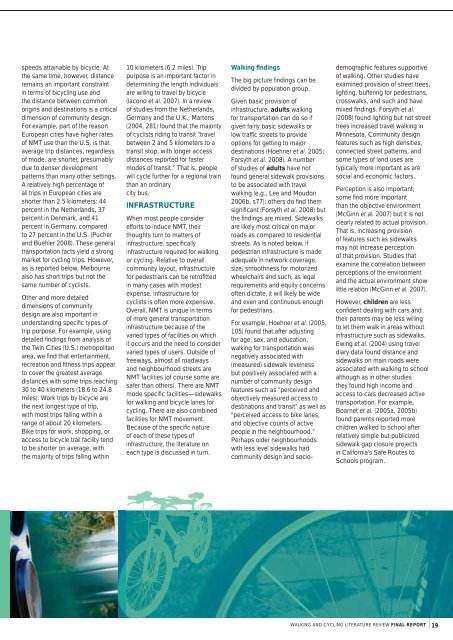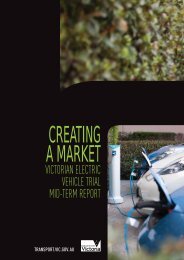Walking and Cycling International Literature Review - Department of ...
Walking and Cycling International Literature Review - Department of ...
Walking and Cycling International Literature Review - Department of ...
You also want an ePaper? Increase the reach of your titles
YUMPU automatically turns print PDFs into web optimized ePapers that Google loves.
speeds attainable by bicycle. At<br />
the same time, however, distance<br />
remains an important constraint<br />
in terms <strong>of</strong> bicycling use <strong>and</strong><br />
the distance between common<br />
origins <strong>and</strong> destinations is a critical<br />
dimension <strong>of</strong> community design.<br />
For example, part <strong>of</strong> the reason<br />
European cities have higher rates<br />
<strong>of</strong> NMT use than the U.S. is that<br />
average trip distances, regardless<br />
<strong>of</strong> mode, are shorter, presumably<br />
due to denser development<br />
patterns than many other settings.<br />
A relatively high percentage <strong>of</strong><br />
all trips in European cities are<br />
shorter than 2.5 kilometers: 44<br />
percent in the Netherl<strong>and</strong>s, 37<br />
percent in Denmark, <strong>and</strong> 41<br />
percent in Germany, compared<br />
to 27 percent in the U.S. (Pucher<br />
<strong>and</strong> Buehler 2008). These general<br />
transportation facts yield a strong<br />
market for cycling trips. However,<br />
as is reported below, Melbourne<br />
also has short trips but not the<br />
same number <strong>of</strong> cyclists.<br />
Other <strong>and</strong> more detailed<br />
dimensions <strong>of</strong> community<br />
design are also important in<br />
underst<strong>and</strong>ing specifi c types <strong>of</strong><br />
trip purpose. For example, using<br />
detailed fi ndings from analysis <strong>of</strong><br />
the Twin Cities (U.S.) metropolitan<br />
area, we fi nd that entertainment,<br />
recreation <strong>and</strong> fi tness trips appear<br />
to cover the greatest average<br />
distances with some trips reaching<br />
30 to 40 kilometers (18.6 to 24.8<br />
miles). Work trips by bicycle are<br />
the next longest type <strong>of</strong> trip,<br />
with most trips falling within a<br />
range <strong>of</strong> about 20 kilometers.<br />
Bike trips for work, shopping, or<br />
access to bicycle trail facility tend<br />
to be shorter on average, with<br />
the majority <strong>of</strong> trips falling within<br />
10 kilometers (6.2 miles). Trip<br />
purpose is an important factor in<br />
determining the length individuals<br />
are willing to travel by bicycle<br />
(Iacono et al. 2007). In a review<br />
<strong>of</strong> studies from the Netherl<strong>and</strong>s,<br />
Germany <strong>and</strong> the U.K., Martens<br />
(2004, 281) found that the majority<br />
<strong>of</strong> cyclists riding to transit “travel<br />
between 2 <strong>and</strong> 5 kilometers to a<br />
transit stop, with longer access<br />
distances reported for faster<br />
modes <strong>of</strong> transit.” That is, people<br />
will cycle further for a regional train<br />
than an ordinary<br />
city bus.<br />
INFRASTRUCTURE<br />
When most people consider<br />
efforts to induce NMT, their<br />
thoughts turn to matters <strong>of</strong><br />
infrastructure, specifi cally<br />
infrastructure required for walking<br />
or cycling. Relative to overall<br />
community layout, infrastructure<br />
for pedestrians can be retr<strong>of</strong>i tted<br />
in many cases with modest<br />
expense. Infrastructure for<br />
cyclists is <strong>of</strong>ten more expensive.<br />
Overall, NMT is unique in terms<br />
<strong>of</strong> more general transportation<br />
infrastructure because <strong>of</strong> the<br />
varied types <strong>of</strong> facilities on which<br />
it occurs <strong>and</strong> the need to consider<br />
varied types <strong>of</strong> users. Outside <strong>of</strong><br />
freeways, almost all roadways<br />
<strong>and</strong> neighbourhood streets are<br />
NMT facilities (<strong>of</strong> course some are<br />
safer than others). There are NMT<br />
mode specifi c facilities—sidewalks<br />
for walking <strong>and</strong> bicycle lanes for<br />
cycling. There are also combined<br />
facilities for NMT movement.<br />
Because <strong>of</strong> the specifi c nature<br />
<strong>of</strong> each <strong>of</strong> these types <strong>of</strong><br />
infrastructure, the literature on<br />
each type is discussed in turn.<br />
<strong>Walking</strong> findings<br />
The big picture fi ndings can be<br />
divided by population group.<br />
Given basic provision <strong>of</strong><br />
infrastructure, adults walking<br />
for transportation can do so if<br />
given fairly basic sidewalks or<br />
low traffi c streets to provide<br />
options for getting to major<br />
destinations (Hoehner et al. 2005;<br />
Forsyth et al. 2008). A number<br />
<strong>of</strong> studies <strong>of</strong> adults have not<br />
found general sidewalk provisions<br />
to be associated with travel<br />
walking (e.g., Lee <strong>and</strong> Moudon<br />
2006b, s77); others do fi nd them<br />
signifi cant (Forsyth et al. 2008) but<br />
the fi ndings are mixed. Sidewalks<br />
are likely most critical on major<br />
roads as compared to residential<br />
streets. As is noted below, if<br />
pedestrian infrastructure is made<br />
adequate in network coverage,<br />
size, smoothness for motorized<br />
wheelchairs <strong>and</strong> such, as legal<br />
requirements <strong>and</strong> equity concerns<br />
<strong>of</strong>ten dictate, it will likely be wide<br />
<strong>and</strong> even <strong>and</strong> continuous enough<br />
for pedestrians.<br />
For example, Hoehner et al. (2005,<br />
105) found that after adjusting<br />
for age, sex, <strong>and</strong> education,<br />
walking for transportation was<br />
negatively associated with<br />
(measured) sidewalk levelness<br />
but positively associated with a<br />
number <strong>of</strong> community design<br />
features such as “perceived <strong>and</strong><br />
objectively measured access to<br />
destinations <strong>and</strong> transit” as well as<br />
“perceived access to bike lanes,<br />
<strong>and</strong> objective counts <strong>of</strong> active<br />
people in the neighbourhood.”<br />
Perhaps older neighbourhoods<br />
with less level sidewalks had<br />
community design <strong>and</strong> sociodemographic<br />
features supportive<br />
<strong>of</strong> walking. Other studies have<br />
examined provision <strong>of</strong> street trees,<br />
lighting, buffering for pedestrians,<br />
crosswalks, <strong>and</strong> such <strong>and</strong> have<br />
mixed fi ndings. Forsyth et al.<br />
(2008) found lighting but not street<br />
trees increased travel walking in<br />
Minnesota. Community design<br />
features such as high densities,<br />
connected street patterns, <strong>and</strong><br />
some types <strong>of</strong> l<strong>and</strong> uses are<br />
typically more important as are<br />
social <strong>and</strong> economic factors.<br />
Perception is also important;<br />
some fi nd more important<br />
than the objective environment<br />
(McGinn et al. 2007) but it is not<br />
clearly related to actual provision.<br />
That is, increasing provision<br />
<strong>of</strong> features such as sidewalks<br />
may not increase perception<br />
<strong>of</strong> that provision. Studies that<br />
examine the correlation between<br />
perceptions <strong>of</strong> the environment<br />
<strong>and</strong> the actual environment show<br />
little relation (McGinn et al. 2007).<br />
However, children are less<br />
confi dent dealing with cars <strong>and</strong><br />
their parents may be less willing<br />
to let them walk in areas without<br />
infrastructure such as sidewalks.<br />
Ewing et al. (2004) using travel<br />
diary data found distance <strong>and</strong><br />
sidewalks on main roads were<br />
associated with walking to school<br />
although as in other studies<br />
they found high income <strong>and</strong><br />
access to cars decreased active<br />
transportation. For example,<br />
Boarnet et al. (2005a, 2005b)<br />
found parents reported more<br />
children walked to school after<br />
relatively simple but publicized<br />
sidewalk gap closure projects<br />
in California’s Safe Routes to<br />
Schools program.<br />
WALKING AND CYCLING LITERATURE REVIEW FINAL REPORT 19

















